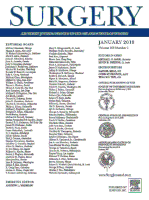Funk LM, Zhang JY, Drosdeck JM, Melvin WS, Walker JP, Perry KA
Surgery. 2015 Jan;157(1):126-36.
BACKGROUND:
The long-term cost effectiveness of medical, endoscopic, and operative treatments for adults with gastroesophageal reflux disease (GERD) remains unclear. We sought to estimate the cost effectiveness of medical, endoscopic, and operative treatments for adults with GERD who require daily proton pump inhibitor (PPI) therapy.
METHODS:
A Markov model was generated from the payer’s perspective using a 6-month cycle and 30-year time horizon. The base-case patient was a 45-year-old man with symptomatic GERD taking 20 mg of omeprazole twice daily. Four treatment strategies were analyzed: PPI therapy, transoral incisionless fundoplication (EsophyX), radiofrequency energy application to the lower esophageal sphincter (Stretta) and laparoscopic Nissen fundoplication. The model parameters were selected using the published literature and institutional billing data. The main outcome measure was the incremental cost-effectiveness ratio (cost per quality-adjusted life-year gained) for each therapy.
RESULTS:
In the base case analysis, which assumed a PPI cost of $234 over 6 months ($39 per month), Stretta and laparoscopic Nissen fundoplication were the most cost-effective options over a 30-year time period ($2,470.66 and $5,579.28 per QALY gained, respectively). If the cost of PPI therapy exceeded $90.63 per month over 30 years, laparoscopic Nissen fundoplication became the dominant treatment option. EsophyX was dominated by laparoscopic Nissen fundoplication at all points in time.
CONCLUSION:
Low-cost PPIs, Stretta, and laparoscopic Nissen fundoplication all represent cost-effective treatment strategies. In this model, when PPIs exceed $90 per month, medical therapy is no longer cost effective. Procedural GERD therapy should be considered for patients who require high-dose or expensive PPIs.
Link to abstract on PubMed: Funk LM, et al; Surgery. 2015 Jan;157(1):126-36.


